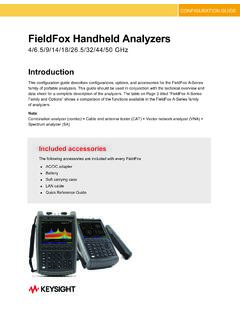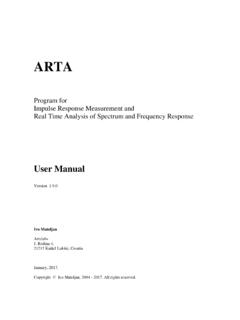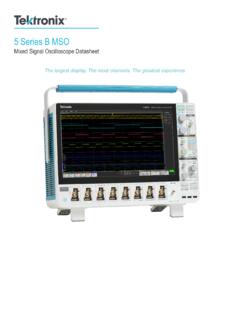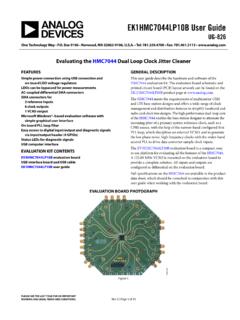Transcription of THE MASTER HANDBOOK OF ACOUSTICS - tka4
1 THE MASTER HANDBOOK . OF ACOUSTICS . This page intentionally left blank. THE MASTER HANDBOOK . OF ACOUSTICS . F. Alton Everest FOURTH EDITION. McGraw-Hill New York San Francisco Washington, Auckland Bogot . Caracas Lisbon London Madrid Mexico City Milan Montreal New Delhi San Juan Singapore Sydney Tokyo Toronto Copyright 2001 by The McGraw-Hill Companies, Inc. All rights reserved. Manufactured in the United States of America. Except as permitted under the United States Copyright Act of 1976, no part of this publication may be reproduced or distributed in any form or by any means, or stored in a database or retrieval system, without the prior written permission of the publisher. 0-07-139974-7. The material in this eBook also appears in the print version of this title: 0-07-136097-2.
2 All trademarks are trademarks of their respective owners. Rather than put a trademark symbol after every occurrence of a trade- marked name, we use names in an editorial fashion only, and to the benefit of the trademark owner, with no intention of infringe- ment of the trademark. Where such designations appear in this book, they have been printed with initial caps. McGraw-Hill eBooks are available at special quantity discounts to use as premiums and sales promotions, or for use in corporate training programs. For more information, please contact George Hoare, Special Sales, at or (212). 904-4069. TERMS OF USE. This is a copyrighted work and The McGraw-Hill Companies, Inc. ( McGraw-Hill ) and its licensors reserve all rights in and to the work.
3 Use of this work is subject to these terms. Except as permitted under the Copyright Act of 1976 and the right to store and retrieve one copy of the work, you may not decompile, disassemble, reverse engineer, reproduce, modify, create derivative works based upon, transmit, distribute, disseminate, sell, publish or sublicense the work or any part of it without McGraw-Hill's prior con- sent. You may use the work for your own noncommercial and personal use; any other use of the work is strictly prohibited. Your right to use the work may be terminated if you fail to comply with these terms. THE WORK IS PROVIDED AS IS . McGRAW-HILL AND ITS LICENSORS MAKE NO GUARANTEES OR WARRANTIES. AS TO THE ACCURACY, ADEQUACY OR COMPLETENESS OF OR RESULTS TO BE OBTAINED FROM USING THE.
4 WORK, INCLUDING ANY INFORMATION THAT CAN BE ACCESSED THROUGH THE WORK VIA HYPERLINK OR. OTHERWISE, AND EXPRESSLY DISCLAIM ANY WARRANTY, EXPRESS OR IMPLIED, INCLUDING BUT NOT LIMITED. TO IMPLIED WARRANTIES OF MERCHANTABILITY OR FITNESS FOR A PARTICULAR PURPOSE. McGraw-Hill and its licensors do not warrant or guarantee that the functions contained in the work will meet your requirements or that its operation will be uninterrupted or error free. Neither McGraw-Hill nor its licensors shall be liable to you or anyone else for any inaccuracy, error or omission, regardless of cause, in the work or for any damages resulting therefrom. McGraw-Hill has no responsibility for the con- tent of any information accessed through the work.
5 Under no circumstances shall McGraw-Hill and/or its licensors be liable for any indirect, incidental, special, punitive, consequential or similar damages that result from the use of or inability to use the work, even if any of them has been advised of the possibility of such damages. This limitation of liability shall apply to any claim or cause what- soever whether such claim or cause arises in contract, tort or otherwise. DOI: To Bonnie Gail, whose love of art, nature, and the author now embraces ACOUSTICS . This page intentionally left blank. CONTENTS. Epigraph xxi Introduction xxiii Chapter 1 Fundamentals of Sound 1. The Simple Sinusoid 2. Sine-Wave Language 3. Propagation of sound 5. The dance of the particles 5.
6 How a sound wave is propagated 7. Sound in free space 9. Wavelength and Frequency 10. Complex Waves 12. Harmonics 12. Phase 12. Partials 15. Octaves 15. The concept of spectrum 17. Electrical, Mechanical, and Acoustical Analogs 20. Chapter 2 Sound Levels and the Decibel 23. Ratios vs. Differences 23. Handling numbers 25. Logarithms 26. Decibels 26. Reference Levels 28. Logarithmic and Exponential Forms Compared 30. Acoustic Power 31. Copyright 2001 The McGraw-Hill Companies, Inc. Click Here for Terms of Use. viii CONTENTS. Using Decibels 33. Example: Sound-pressure level 34. Example: Loudspeaker SPL 34. Example: Microphone specifications 35. Example: Line amplifier 35. Example: General-purpose amplifier 35. Example: Concert hall 35.
7 Example: Combining decibels 36. Ratios and Octaves 37. Measuring Sound-Pressure Level 39. Chapter 3 The Ear and the Perception of Sound 41. Sensitivity of the Ear 41. A Primer of Ear Anatomy 42. The pinna: Directional encoder of sound 43. Directional cues: An experiment 44. The ear canal 44. The middle ear 45. The inner ear 48. Stereocilia 49. Loudness vs. Frequency 50. Loudness Control 51. Area of Audibility 53. Loudness vs. Sound-Pressure Level 54. Loudness and Bandwidth 56. Loudness of Impulses 59. Audibility of Loudness Changes 61. Pitch vs. Frequency 61. An experiment 63. Timbre vs. spectrum 63. Localization of Sound Sources 64. Binaural Localization 67. Aural harmonics: Experiment #1 68. Aural harmonics: Experiment #2 69.
8 The missing fundamental 69. The Ear as an analyzer 70. The Ear as a Measuring Instrument 70. An auditory analyzer : An experiment 71. CONTENTS. ix Meters vs. the Ear 72. The Precedence Effect 73. Perception of Reflected Sound 75. Occupational and Recreational Deafness 76. Summary 79. Chapter 4 Sound Waves in the Free Field 83. Free Sound Field: Definition 83. Sound Divergence 84. Examples: Free-field sound divergence 84. Inverse square in enclosed spaces 87. Hemispherical propagation 88. Chapter 5 Speech, Music, and Noise 89. The Voice System 89. Artificial larynx 89. Sound spectrograph 90. Sound sources for speech 92. Vocal tract molding of speech 92. Formation of voiced sounds 94. Formation of unvoiced sounds 95. Putting it all together 95.
9 Synthesized speech 96. Digital speech synthesis 97. Directionality of speech 98. Music 99. Wind instruments 101. Nonharmonic overtones 101. Dynamic range of speech and music 101. Power in Speech and Music 103. Frequency Range of Speech and Music 104. Future Dynamic-Range Requirements 104. Auditory Area 104. Noise 107. Noise The good kind 108. Random noise 109. White and pink noise 111. Signal Distortion 112. Harmonic Distortion 114. x CONTENTS. Chapter 6 Analog and Digital Signal Processing 119. Resonance 120. Filters 122. Active filters 123. Analog vs. digital filters 124. Digitization 125. Quantization 126. Digital filters 126. Application of Digital Signal Processing (DSP) 105. Application of DSP to Room Equalization 106.
10 Chapter 7 Reverberation 129. Reverberation and Normal Modes 130. Growth of Sound in a Room 132. Decay of Sound in a Room 134. Idealized Growth and Decay of Sound 134. Reverberation Time 135. Measuring Reverberation Time 137. Impulse Sound Sources 137. Steady-State Sources 138. Equipment 138. Measurement Procedure 140. Analysis of decay traces 140. Mode Decay Variations 142. Writing speed 143. Frequency effect 144. Reverberation Time Variation with Position 145. Acoustically Coupled Spaces 146. Electroacoustically Coupled Spaces 146. Decay rate 147. Eliminating decay fluctuations 147. Influence of Reverberation on Speech 148. Influence of Reverberation on Music 149. Optimum Reverberation Time 150. Bass rise of reverberation time 152.





